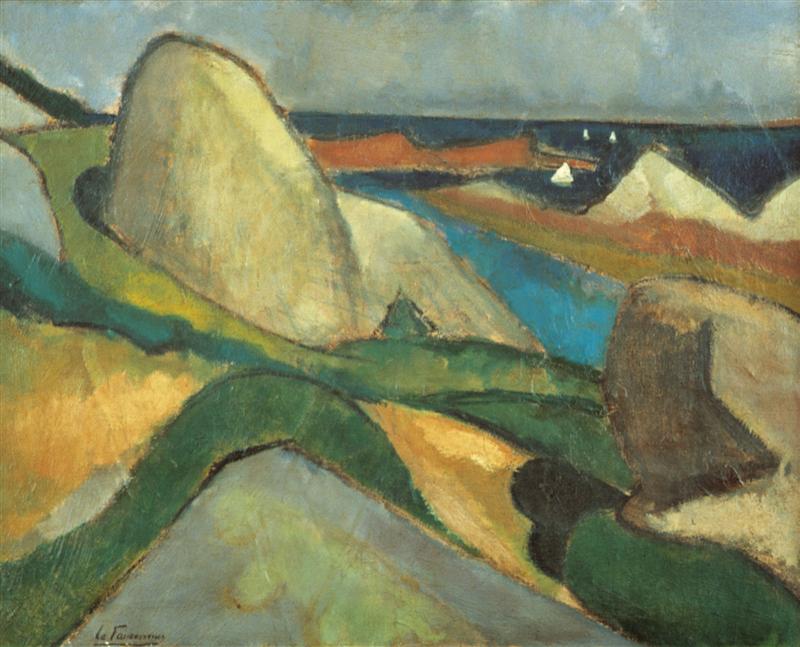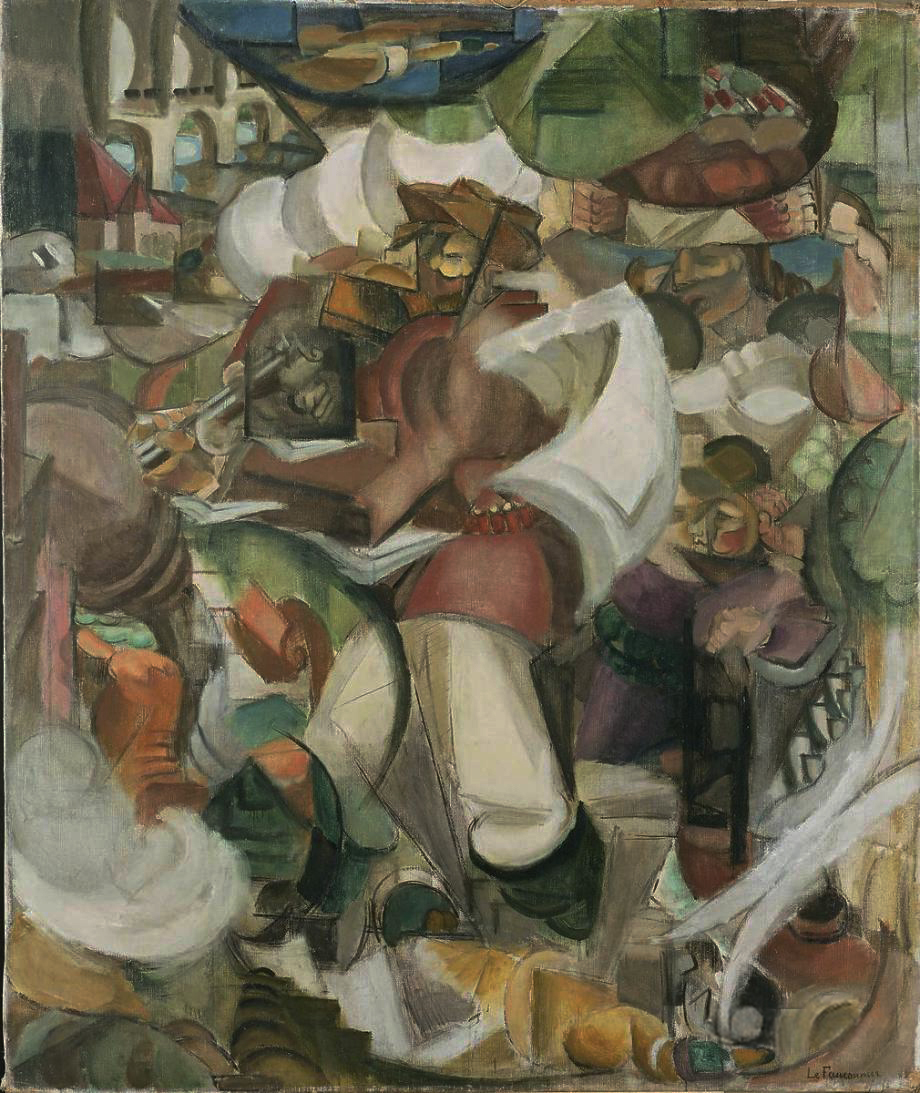Henri Le Fauconnier (L'Abondance), Jean Metzinger, (Le Goûter), Robert Delaunay (La Tour Eiffe on:
[Wikipedia]
[Google]
[Amazon]
Henri Victor Gabriel Le Fauconnier (July 5, 1881 – December 25, 1946) was a French Cubist painter born in Hesdin. Le Fauconnier was seen as one of the leading figures among the Montparnasse Cubists. At the 1911 Salon des Indépendants Le Fauconnier and colleagues Jean Metzinger, Albert Gleizes,
/ref>
 In 1901 Henri Le Fauconnier moved from northern France to Paris, where he studied law, then attended painting classes in the studio of
In 1901 Henri Le Fauconnier moved from northern France to Paris, where he studied law, then attended painting classes in the studio of
In 1912, Le Fauconnier participated in the first exhibition of Cubism in Spain, at Galeries Dalmau, Barcelona, with Jean Metzinger, Albert Gleizes, Marcel Duchamp, Juan Gris, Marie Laurencin, and August Agero.Mercè Vidal, ''L'exposició d'Art Cubista de les Galeries Dalmau 1912''
Edicions Universitat Barcelona, 1996, Elisenda Andrés Pàmies, ''Les Galeries Dalmau, un projecte de modernitat a la ciutat de Barcelona''
2012-13, Facultat d’Humanitats, Universitat Pompeu FabraWilliam H. Robinson, Jordi Falgàs, Carmen Belen Lord, ''Barcelona and Modernity: Picasso, Gaudí, Miró, Dalí''
Cleveland Museum of Art, Metropolitan Museum of Art (New York), Yale University Press, 2006, Le Fauconnier was a contributing member of the Section d'Or (Puteaux Group). At the outset of World War I Le Fauconnier moved to the Netherlands where he stayed for six years. His work at this time combined Cubism and
 * ''Femme nue dans un intérieur'', Lyon, Musée des Beaux-Arts
* ''L’Église de Grosrouvre'', Lyon, Musée des Beaux-Arts
* ''L’Enfant breton'', Lyon, Musée des Beaux-Arts
* ''Nature morte aux fleurs'', Beauvais, Musée Départemental de l’Oise
* ''Paysage'', Lyon, Musée des Beaux-Arts
* ''Portrait de vieille femme'', Lyon, Musée des Beaux-Arts
* ''Maisons dans les rochers à Ploumanac'h'', Brest, Musée des Beaux-Arts
* ''Femme nue dans un intérieur'', Lyon, Musée des Beaux-Arts
* ''L’Église de Grosrouvre'', Lyon, Musée des Beaux-Arts
* ''L’Enfant breton'', Lyon, Musée des Beaux-Arts
* ''Nature morte aux fleurs'', Beauvais, Musée Départemental de l’Oise
* ''Paysage'', Lyon, Musée des Beaux-Arts
* ''Portrait de vieille femme'', Lyon, Musée des Beaux-Arts
* ''Maisons dans les rochers à Ploumanac'h'', Brest, Musée des Beaux-Arts
Hermitage Museum, Saint Petersburg, Russia
''The Lake'', 1911, ''Village among the Rocks'', ca.1910, ''Little Schoolgirl'', 1907, ''The Signal'', 1915
''The Huntsman'' (Le chasseur), 1912
The Modernist Journals Project
{{DEFAULTSORT:Le Fauconnier, Henri Cubist artists 19th-century French painters French male painters 20th-century French painters 20th-century French male artists 1881 births 1946 deaths Art educators 19th-century French male artists
Fernand Léger
Joseph Fernand Henri Léger (; February 4, 1881 – August 17, 1955) was a French painting, painter, sculpture, sculptor, and film director, filmmaker. In his early works he created a personal form of cubism (known as "tubism") which he gradually ...
and Robert Delaunay caused a scandal with their Cubist paintings. He was in contacts with many European avant-garde artists such as Wassily Kandinsky, writing a theoretical text for the catalogue of the Neue Künstlervereinigung in Munich, of which he became a member. His paintings were exhibited in Moscow reproduced as examples of the latest art in '' Der Blaue Reiter Almanach'' (''The Blue Rider Almanac'').Hermitage Amsterdam, Artist biographies, Henri Le Fauconnier/ref>
Career
 In 1901 Henri Le Fauconnier moved from northern France to Paris, where he studied law, then attended painting classes in the studio of
In 1901 Henri Le Fauconnier moved from northern France to Paris, where he studied law, then attended painting classes in the studio of Jean-Paul Laurens
Jean-Paul Laurens (; 28 March 1838 – 23 March 1921) was a French painter and sculptor, and one of the last major exponents of the French Academic style.
Biography
Laurens was born in Fourquevaux and was a pupil of Léon Cogniet and Alexand ...
, then in the Academie Julian
An academy (Attic Greek: Ἀκαδήμεια; Koine Greek Ἀκαδημία) is an institution of secondary or tertiary higher learning (and generally also research or honorary membership). The name traces back to Plato's school of philosophy, f ...
. He changed his name from Fauconnier to ''Le'' Fauconnier and exhibited at the Salon des Indépendants in 1904 and 1905, implementing bold colors in line with Henri Matisse. He moved to Brittany in 1907 and painted the rocky landscapes of Ploumanac'h in a proto-Cubist style characterized by chastened tones of brown and greens with thick outlines delimiting the simplified forms.
He explored a personal style and put it into practice; painting nudes or portraits (such as that of the poet Pierre Jean Jouve
Pierre Jean Jouve (11 October 1887 – 8 January 1976) was a French writer, novelist and poet.Michael Sheringham, 'Jouve, Pierre-Jean', ''Oxford Companion to French Literature''Onlineat answers.com He was nominated for the Nobel Prize in Literat ...
in 1909 ( Musée National d'Art Moderne). Under the influence of Paul Cézanne
Paul Cézanne ( , , ; ; 19 January 1839 – 22 October 1906) was a French artist and Post-Impressionism, Post-Impressionist painter whose work laid the foundations of the transition from the 19th-century conception of artistic endeavour to a ...
he developed his own form of Cubism
Cubism is an early-20th-century avant-garde art movement that revolutionized European painting and sculpture, and inspired related movements in music, literature and architecture. In Cubist artwork, objects are analyzed, broken up and reassemble ...
. Back in Paris, he mingles with the artistic and literary gathered around Paul Fort at the Closerie des Lilas in Montparnasse.
At the 1909 Salon d’Automne Le Fauconnier exhibited alongside Constantin Brâncuși
Constantin Brâncuși (; February 19, 1876 – March 16, 1957) was a Romanian Sculpture, sculptor, painter and photographer who made his career in France. Considered one of the most influential sculptors of the 20th-century and a pioneer of ...
, Jean Metzinger and Fernand Léger
Joseph Fernand Henri Léger (; February 4, 1881 – August 17, 1955) was a French painting, painter, sculpture, sculptor, and film director, filmmaker. In his early works he created a personal form of cubism (known as "tubism") which he gradually ...
.
Louis Vauxcelles, in his review of the 1910 Salon des Indépendants, made a passing and inaccurate reference to Le Fauconnier, Jean Metzinger, Albert Gleizes, Robert Delaunay and Fernand Léger
Joseph Fernand Henri Léger (; February 4, 1881 – August 17, 1955) was a French painting, painter, sculpture, sculptor, and film director, filmmaker. In his early works he created a personal form of cubism (known as "tubism") which he gradually ...
, as "ignorant geometers, reducing the human body, the site, to pallid cubes."
Metzinger had written in 1910 of 'mobile perspective' as an interpretation of what would soon become known as "Cubism" with respect to Picasso, Braque, Delaunay and Le Fauconnier.
At the invitation of Wassily Kandinsky, Le Fauconnier published a theoretical text in the catalog of the Neue Künstlervereinigung (Munich, 1910). He opened his Rue Visconti studio in Paris to artists eager like him to apply the lessons of Cézanne. With Jean Metzinger, Albert Gleizes, Fernand Léger, Robert Delaunay, he contributed to the Cubist scandal of the 1911 Salon des Indépendants. Le Fauconnier exhibited his vast ''Les Montagnards attaqués par des ours'' (''Mountaineers Attacked by Bears'') at the Salon d'Automne of 1912 (Paris).
February 1912 Henri Le Fauconnier was appointed to succeed Jacques-Émile Blanche
Jacques-Émile Blanche (; 1 January 1861 – 30 September 1942) was a French artist, largely self-taught, who became a successful portrait painter, working in London and Paris.
Early life
Blanche was born in Paris. His father, whose name he s ...
as ''chef d'atelier'' of the avant-garde school of art Académie de La Palette
''Académie de La Palette'', also called ''Académie La Palette'' and ''La Palette'', (English: ''Palette Academy''), was a private art school in Paris, France, active between 1888 and 1925, aimed at promoting'' 'conciliation entre la liberté et l ...
. Le Fauconnier commissioned Jean Metzinger and André Dunoyer de Segonzac as full-time instructors for the morning sessions; Eugeniusz Żak
Eugeniusz Zak (15 December 1884 – 15 January 1926), also known as Eugène Zak and Eugene Zak, was a Polish artist.
Life
Eugeniusz Zak was born to Jewish family in Mogilno, Minsk Governorate (nowadays Belarus). As a boy he moved to Warsaw, ...
(Eugène Zak) and Jean Francis Auburtin took over in the afternoon.Academies in Paris, Kubisme.info (Dutch)In 1912, Le Fauconnier participated in the first exhibition of Cubism in Spain, at Galeries Dalmau, Barcelona, with Jean Metzinger, Albert Gleizes, Marcel Duchamp, Juan Gris, Marie Laurencin, and August Agero.
Edicions Universitat Barcelona, 1996,
2012-13, Facultat d’Humanitats, Universitat Pompeu FabraWilliam H. Robinson, Jordi Falgàs, Carmen Belen Lord, ''Barcelona and Modernity: Picasso, Gaudí, Miró, Dalí''
Cleveland Museum of Art, Metropolitan Museum of Art (New York), Yale University Press, 2006, Le Fauconnier was a contributing member of the Section d'Or (Puteaux Group). At the outset of World War I Le Fauconnier moved to the Netherlands where he stayed for six years. His work at this time combined Cubism and
Expressionism
Expressionism is a modernist movement, initially in poetry and painting, originating in Northern Europe around the beginning of the 20th century. Its typical trait is to present the world solely from a subjective perspective, distorting it rad ...
, which generated considerable success and influence in the Netherlands. He returned to France in 1920 where his paintings became more realistic.
He died of a heart attack in Paris (1946).
Works
 * ''Femme nue dans un intérieur'', Lyon, Musée des Beaux-Arts
* ''L’Église de Grosrouvre'', Lyon, Musée des Beaux-Arts
* ''L’Enfant breton'', Lyon, Musée des Beaux-Arts
* ''Nature morte aux fleurs'', Beauvais, Musée Départemental de l’Oise
* ''Paysage'', Lyon, Musée des Beaux-Arts
* ''Portrait de vieille femme'', Lyon, Musée des Beaux-Arts
* ''Maisons dans les rochers à Ploumanac'h'', Brest, Musée des Beaux-Arts
* ''Femme nue dans un intérieur'', Lyon, Musée des Beaux-Arts
* ''L’Église de Grosrouvre'', Lyon, Musée des Beaux-Arts
* ''L’Enfant breton'', Lyon, Musée des Beaux-Arts
* ''Nature morte aux fleurs'', Beauvais, Musée Départemental de l’Oise
* ''Paysage'', Lyon, Musée des Beaux-Arts
* ''Portrait de vieille femme'', Lyon, Musée des Beaux-Arts
* ''Maisons dans les rochers à Ploumanac'h'', Brest, Musée des Beaux-Arts
References
External links
Hermitage Museum, Saint Petersburg, Russia
''The Lake'', 1911, ''Village among the Rocks'', ca.1910, ''Little Schoolgirl'', 1907, ''The Signal'', 1915
''The Huntsman'' (Le chasseur), 1912
The Modernist Journals Project
{{DEFAULTSORT:Le Fauconnier, Henri Cubist artists 19th-century French painters French male painters 20th-century French painters 20th-century French male artists 1881 births 1946 deaths Art educators 19th-century French male artists